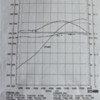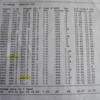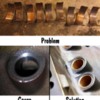The 351C has a propensity for rod bearing wear. The symptoms of insufficient lubrication are evident even in low mileage and gently operated engines; those symptoms include ribbons of bearing material lying in the bottom of the oil pan, scoring of the bearings, bearings that have sections which have been polished by the crankshaft, or bearings in which the silver colored top layer of bearing material has been worn through to expose the copper colored substrate.
Lubrication system pressure is supposed to be controlled by a relief valve built into the 351C oil pump. The setting of the relief valve is controlled by a spring intended by the designers to maintain 60 psi nominal hot oil pressure by 2000 rpm (50 psi minimum). Hot oil pressure below 50 psi is common for a 351C however. Hot oil pressure below 50 psi indicates the relief valve is fully closed yet the oil pump cannot supply enough oil. An excessive amount of oil is therefore flowing into various "clearances”, overtaxing the pump’s capacity. Some of those clearances are the result of excessive rod bearing wear.
The engine block is designed with only two “main oil passages”, each positioned within the block so as to intersect one of the two rows of tappet bores; secondary passages supplying the three central main bearings branch-off from the right hand passage. The degree to which the main oil passages intersect the tappet bores creates large ports in the side of each tappet bore, and establishes an over-sized connection between each tappet bore and the main oil passage. The over-sized connections between the tappet bores and the main oil passages create three problems:
First they allow cavitation created by tappet motion to impede the amount of oil flowing to the main bearings. This leads to insufficient lubrication of the rod bearings and causes excessive rod bearing wear and damage. Oil not only lubricates bearings, it cools them as well; at some point above 7000 rpm the rod bearings fail completely due to under-lubrication and over-heating; the bearings for connecting rod #2 or connecting rod #7 are usually the first to fail due to the “clocking” of the crankshaft oil passages supplying those bearings.
Second, the over-sized connections allow an excessive amount of oil to be wasted via the tappet clearances. Oil wasted via the tappet clearances and via the clearances caused by worn rod bearings over taxes the oil pump’s capacity and makes it impossible to achieve Ford's hot oil pressure specification (60 psi nominal, 50 psi minimum at 2000 rpm).
Third, the over-sized connections create tappet compatibility issues. Tappets having the wrong oil metering design (such as edge-orifice metering) supply too much oil to the valve train. The oil pan can be "pumped dry" when an engine equipped with the wrong tappets is operated continuously at high speed. Ford found it necessary to redesign the tappets installed in the 351C because tappets designed for the small block Ford and 351 Windsor allowed too much oil to flow to the 351 Cleveland valve train.
The use of the 351 Cleveland in higher level racing began in 1971 (and was in full swing by 1972). The 1971 race season was the year they discovered the 351C had a problem lubricating the rod bearings. After their earliest attempts to fix the problem failed the tappet bore bushings were tested in 1973 by Ford sponsored (or formerly sponsored) race teams who found the bushings were successful at alleviating the problem. Tappet bore bushings replace the over-sized connections between the tappet bores and the main oil passages with small orifices, typically 0.060 inch. Since under lubrication of the rod bearings caused catastrophic bearing failure above 7000 rpm, tappet bore bushings have been considered a necessity by informed racers since 1973.
Ford literature regarding the bushings does not exist however, because 1973 was the year Ford stopped promoting high performance and racing, they stopped selling high performance parts, and they stopped publishing the OHO Newsletter. News of the tappet bore bushings was therefore spread by word-of-mouth only ... and Ford’s bushing installation kit was sold under-the-table. Typical of professional racing, some teams shared the information about the tappet bore bushings while others chose not to share the information, hoping to gain an advantage over other teams.
The Cleveland was notorious for lubrication issues not only amongst racers and but at Ford service departments as well. Consider this testimonial:
quote:
“... I worked as a Ford dealership mechanic for 14 years, starting back in 1970. I replaced many main and rod bearings in the 351C, 351M and 400 engines. Those cars and pickup trucks were driven on the street and probably by older drivers. They didn't even have high miles and the engines were lucky to see 4000 RPM's. The mains and rods would become so worn, the oil pressure warning light would flicker on when the engine was hot, during idle and low RPM's. These engines were known for their oiling problems ...
The 351C lubrication issues are not isolated to high rpm racing, the issues impact street engines as well. At lower engine speeds the under lubrication of the rod bearings does not cause catastrophic bearing failure as it does at higher rpm, but it does result in excessive rod bearing wear. The use of heavy duty tri-metal bearings masks the problem in street engines somewhat because they are not damaged as badly as standard babbitt bearings, but the heavy duty bearings experience unwanted wear just the same.
Tappet bore bushings were for a long time considered unnecessary for street engines however. This opinion was rationalized by the fact that the expense of their installation was too high to spend on a street engine, considering that the rod bearings did not catastrophically fail in street engines limited to 6200 rpm or less. The reasonably priced tappet bore bushing installation kit sold by Wydendorf Machine changes all that, the arguments against tappet bore bushings have become a moot point, the kit makes tappet bore bushings a viable solution for all Cleveland engines. The price of the Wydendorf kit is less than what some people spend on valve covers, it is financially accessible to mechanics rebuilding a Cleveland engine on even the most modest budget. It no longer makes any sense to argue against tappet bore bushings, there is no longer a reason for any Cleveland engine to be plagued with abnormal rod bearing wear or any other lubrication related issue.






